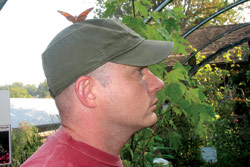Cheap beer and chain saws are a troubling combination. I haven't been able to enjoy sitting on our back deck since my husband, Scott, acquired his latest outdoor toy.

The sight of him on our 45-degree, terraced hill, PBR in one hand and fauna-slaughtering device in the other, is decidedly too much for my jumpy nerves. But I try to be understanding: His current obsession with landscaping seems to have renewed a spiritual connection with his late maternal grandfather, "Pops" Loring, who, for the most part, raised him. "Pops" kept a strictly maintained lawn at his Myers Park home in Charlotte.
Still, I'm not sure Pops would have taken out a thriving butterfly bush as Scott did recently, citing its encroachment on his pet spread of periwinkle. A large section of my beloved grape arbor is likewise gone ("It was strangling the fence," he said sheepishly). Fortunately, the remaining muscadines won't ripen till September, so I have a month or two before I really miss those vines.
Right now I'm mainly mourning the butterfly bush; last year, the dark-magenta flowers on our Buddleia davidii attracted myriad butterflies, chief among them great spangled fritillaries and pale-yellow tiger swallowtails.
Determined to lure those winged lovelies back, or at least to enjoy bunches of butterflies all at once, I recently visited the Western North Carolina Nature Center's "Beauty of Butterflies" showcase, a 15-by-40-foot, walk-through hoop garden that provides a rarefied atmosphere for some 300 insects. Inside, time pauses — an enchanted held breath. On the exhibit's opening "Nectar Collector" day last month, human visitors swarmed the enclosure, and yet the vibe hummed low. Junior Naturalists, the Center's teenage volunteers, sprayed sugar water on children's hands so they could host gracefully flitting monarchs. Black spicebush swallowtails flapped thoughtfully on various blooms, and enormous, ghostlike luna moths studded the hoop's ceiling like soft origami scraps.
In all, around 25 species were represented that day, according to Education Program Specialist Eli Strull. "We only feature moths and butterflies that are native to our region," says Strull, who reveals that the exhibit's butterflies are purchased from special breeders throughout the South. "We acquire captive-reared butterflies so that we are not impacting our native populations," he explains. In fact, part of the program's mission involves addressing the mysteriously dwindling numbers of monarchs. The Nature Center will even hold a monarch-tagging workshop in September.
But mostly the butterflies are just there to be enjoyed. "The exhibit is designed to give people a personal experience, surrounding them with a live native [animal] that is charismatic," says Strull. "We hope this will excite people to a higher level of interest, and they'll want to learn more."
Here are a few facts for the lay admirer: Butterflies taste with their feet. Once hatched from their chrysalises, they live for about two weeks — except for the last generation in a season's cycle of monarchs, which survives much longer in order to migrate. And the main way to tell a moth from a butterfly is by what caps their respective antennae: Moths have feathery shapes at the ends of theirs; butterflies have tight clubs.
"Most moths," adds Strull, "will not eat your sweaters. That's a myth." The hoop garden boasts some extravagantly colored silk moths as wide and thick as small birds. Intent on pollinating flowers, they hardly look hungry for cable knit.
That brings me back to my original mission: finding out how to lure butterflies to our backyard absent an obvious food source. Not surprisingly, Buddleia are among the Nature Center exhibit's primary floral magnets. But a vast variety of plants will lure nectar collectors, says Strull, including various coneflowers (such as black-eyed Susans) and herbs such as fennel, parsley and dill. Other butterfly enticers include joe-pye weed, Shasta daisy, thistle, aster and goldenrod.
"They like flowers that grow in clusters," he notes. "And planting in groupings is important. For instance, they'd be much more attracted to six black-eyed Susans than to one. Being the efficiency experts that they are, butterflies appreciate not having to work hard."
True to their carefree reputation, they also seem to hold no grudges. During a repeat visit to the hoop garden, butterflies alighted, one after another, on Scott's head, as if to say, "All is forgiven."
The WNC Nature Center's "Beauty of Butterflies" exhibit runs through Monday, Sept. 7. For information, visit www.wildwnc.org or call 298-5600.
Melanie McGee Bianchi is a stay-at-home mom and freelance journalist.
Black spicebush swallowtails flapped thoughtfully on various blooms, and enormous, ghostlike luna moths studded the hoop's ceiling like soft origami scraps.



Before you comment
The comments section is here to provide a platform for civil dialogue on the issues we face together as a local community. Xpress is committed to offering this platform for all voices, but when the tone of the discussion gets nasty or strays off topic, we believe many people choose not to participate. Xpress editors are determined to moderate comments to ensure a constructive interchange is maintained. All comments judged not to be in keeping with the spirit of civil discourse will be removed and repeat violators will be banned. See here for our terms of service. Thank you for being part of this effort to promote respectful discussion.